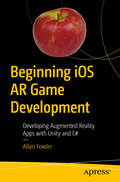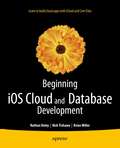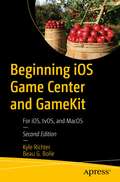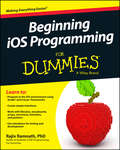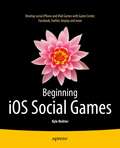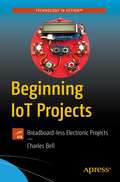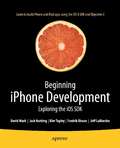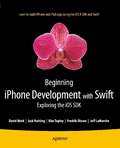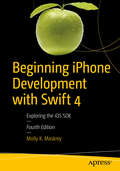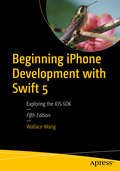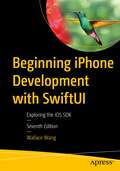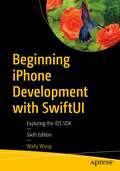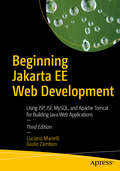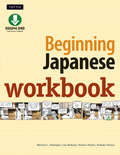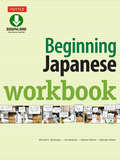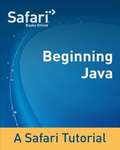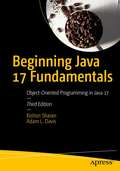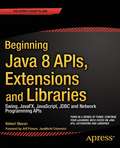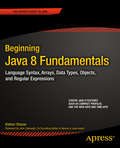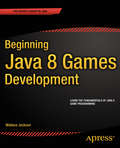- Table View
- List View
Beginning iOS AR Game Development: Developing Augmented Reality Apps with Unity and C#
by Allan FowlerCreate a fully featured application that’s both sophisticated and engaging. This book provides a detailed guide in developing augmented reality games that can take advantage of the advanced capabilities of new iOS devices and code while also offering compatibility with still supported legacy devices. No programming experience is necessary as this book begins on the ground floor with basic programming concepts in Unity and builds to incorporating input from the real world to create interactive realities. You’ll learn to program with the Unity 2017 development platform using C#. Recent announcements of increased AR capabilities on the latest iPhones and iPads show a clear dedication on Apple’s part to this emerging market of immersive games and apps. Unity 2017 is the latest version of this industry leading development platform and C# is a ubiquitous programming language perfect for any programmer to begin with. Using the latest development technologies, Beginning iOS AR Game Development will show you how to program games that interact directly with the real world environment around the user for creative fantastic augmented reality experiences.What You'll LearnDownload assets from the Unity storeCreate a scene in Unity 2017Use physics and controls on mobile devicesWho This Book Is ForBeginner programmers and/or people new to developing games using Unity. It also serves as a great introduction to developing AR games and educators teaching the subject at high school or higher levels.
Beginning iOS Cloud and Database Development: Build Data-Driven Cloud Apps for iOS
by Brian Miller Nathan Ooley Nick TichawaBeginning iOS Cloud and Database Development gets you started with building apps that use Apple's iCloud. You'll learn the techniques which will enable you to devise and create iOS apps that can interact with iCloud servers. From the basics up, you'll progressively learn how to configure your app for iCloud, upload and download files, implement revisions, add conflict resolution policies, and work with custom documents. There's more! You'll learn how to integrate iCloud with Core Data based applications. Besides technical advice, you'll find suggestions and best practices to design the interaction of iCloud-driven applications. According to many industry sources, analysts, and shows, Apple will rely more and more on iCloud or web apps in the cloud to store and stream data-intensive media and other kinds of apps. As the majority of apps use some sort of data--and that only will grow as apps become more complex with rich and streaming media--this book shows developers how to create apps for iCloud, Apple's new cloud computing storage and data service. What you'll learn How to use, design, and develop for iCloud, including iOS data-driven apps, media apps and more How to work with documents in iCloud How to create custom documents in iCloud How to work with Core Data and iCloud Who this book is for This book is for iOS developers who want to build apps for or that use the new iCloud platform. Table of Contents Cloud Database Development: The Basics Introduction to The Cloud Applications for the Cloud Basic Setup of iCloud and Key-Value Storage iCloud Document Storage with Core Data and UIDocument iCloud with Core Data Connections, Testing, and Submission for Apple
Beginning iOS Game Center and GameKit: For iOS, tvOS, and MacOS
by Kyle Richter Beau G. BolleCreate fun and polished games and gamify your apps with GameKit and Game Center. This fully updated new edition of Kyle Richter’s classic can help you reach new customers through social integrations, multiplayer, and achievements. Quickly add a level of polish to your apps that used to take weeks of hard work and late nights.Implementing a leaderboard and achievement system has never been so simple! Gone are the days of writing and maintaining your own server. You'll also see how to easily add advanced networking concepts like VoIP support in hours, not days. Game Center is heavily pushed and promoted by Apple. By adding Game Center into your game, not only do you gain access to polished and professional features but your app will see a boost in downloads and sharing.Expeditiously implement a plethora of advanced social networking concepts into your apps. Create custom Game Center Manager classes that can be rapidly deployed into any of your new or existing projects. And jump right over pitfalls commonly encountered by new and experienced Game Center developers. Become a Game Center development champ! What You'll LearnBuild a reusable Game Center manager class that can be quickly used in future projectsIntegrate Game Kit and Game Center leaderboards and Achievements into your projectAdd real time and turned based multiplayer functionality to your gameImplement a real time voice chat systemWho This Book Is ForExperienced developers who already have a basic understanding of iOS development but haven’t yet had a chance to work with GameKit technology will benefit from this book.
Beginning iOS Game Development
by Patrick AlessiGet in the game and start building games for the iPhone or iPad! Whether you only have a little experience with iOS programming or even none at all, this accessible guide is ideal for getting started developing games for the iPhone and iPad. Experienced developer and author Patrick Alessi presents the iOS system architecture, gives you the step-by-step of game development, and introduces the languages used to develop games. From the basic building blocks to including drawing, responding to user interaction, animation, and sound, this book provides a one-stop-shop for getting your game up and running, Explores the tools and methodology used to develop games for the iPhone and iPad Requires no previous experience with building a game for the iOS platform Details how iOS games require different considerations than other applications Addresses working with the Xcode programming environment, how to draw with the Quartz 2D API, ways to handle user input, and techniques for incorporating animation with Core Animation and sound with Core Audio If you're ready to jump on the gaming app bandwagon, then this book is what you need to get started!
Beginning iOS Game Development
by Patrick AlessiGet in the game and start building games for the iPhone or iPad! Whether you only have a little experience with iOS programming or even none at all, this accessible guide is ideal for getting started developing games for the iPhone and iPad. Experienced developer and author Patrick Alessi presents the iOS system architecture, gives you the step-by-step of game development, and introduces the languages used to develop games. From the basic building blocks to including drawing, responding to user interaction, animation, and sound, this book provides a one-stop-shop for getting your game up and running. Explores the tools and methodology used to develop games for the iPhone and iPad Requires no previous experience with building a game for the iOS platform Details how iOS games require different considerations than other applications Addresses working with the Xcode programming environment, how to draw with the Quartz 2D API, ways to handle user input, and techniques for incorporating animation with Core Animation and sound with Core Audio If you're ready to jump on the gaming app bandwagon, then this book is what you need to get started!
Beginning iOS Media App Development
by Ahmed BakirBeginning iOS Media App Development is a ground-breaking tutorial that explores the near limitless, programmable audio-visual capabilities of the iPhone, iPad and iPod touch using real-world examples and thorough explanations of the code. This book includes detailed step-by-step instructions and important background information from experienced media and utility app developer, Ahmed Bakir. You'll learn about content creation, playback, and advanced topics, including AirPlay, AVKit, and Swift. Each chapter is framed with a project that illustrates the concepts being discussed and pulls in lessons from other popular apps. You'll even learn about the latest iOS 8 and Xcode 6 media features. After reading this book, you should be able to build your first rich media app or utility app that utilizes multimedia for the App Store. And if you're a game developer, this book will provide you with tools to help make your game app look even better by integrating native iOS features.
Beginning iOS Programming For Dummies
by Rajiv RamnathThe ultimate beginner's guide to programming in the iOS environmentThe Apple App Store is a gold mine for developers, but with more apps for the iPhone, iPad, and iPod touch being added every day, it?s essential to have a solid programming foundation to create the best apps possible. If you're eager to learn the ins and outs of iOS programming, this is your book. It teaches object-oriented programming within the iOS framework from the ground up, preparing you to create the next super iPhone or iPad app. Get a handle on the iOS framework, object-oriented best practices, and the Xcode programming environment, then discover how to create simple interfaces, use libraries, create and extend objects, and more. Whether you're just starting out in programming or only new to iOS, For Dummies is the perfect beginning.Focuses on teaching object-oriented programming within the iOS framework and includes best practices for building apps that are easy to debug, evolve, and maintainUses simple examples to demonstrate object-oriented programming output in the iPhone environment while teaching real-world programming concepts and applicationsProvides a thorough understanding of the framework and object-oriented principles to help beginning programmers make optimum use of iOSCovers working with the Xcode environment and storyboards; creating simple interfaces; using libraries, functions, structures, arrays, and pointers; and creating and extending objectsBeginning iOS Programming For Dummies is your straightforward guide to getting started with iOS programming.
Beginning iOS Social Games
by Kyle RichterIt's certainly fun to build games that run on your iPhone and iPad. But, wouldn't it be more fun to create games that allow you to play with other gamers in your social network? There's a whole lot more things you can do. Most of the top best selling games around the world, like World of Warcraft, let you play with others online and share your experiences with your friends. Beginning iOS Social Games is your concise introduction to iOS social and other networked gaming app development using iOS Game Center, Game Kit, Store Kit, AirPlay, iOS 7 Game Controllers, iTunes App Store and integrating with social networks/media like Facebook and Twitter. Author Kyle Richter of Empirical Development is an expert game developer who guides you through the social game app development process step by step. This book may allow you to turn your already existing, created game into a well polished networkable and/or social media capable game app. What you'll learn Build socially integrated games on iOS for iPhone and iPad using Twitter and Facebook Configure and begin using Game Center, Apple's social gaming platform Work with the advanced features of Apple's Game Center using leaderboards, achievements, matchmaking, invitations, and multiplayer Exchange data while dealing with errors, dropped connections and other hurdles Create turned-based iOS games using Game Center Implement other socially rich features like real time Voice Chat, In App Purchases with Store Kit, and displaying content on a TV using Airplay Explore all these features and more while building a real iOS game, UFOs! Who this book is for This book is for iPhone and iPad app developers looking to build iOS game apps that can network with other apps and social media like Facebook. Table of Contents Chapter 1: Getting Started With Social Gaming Chapter 2: Game Center: Setting Up and Getting Started Chapter 3: Leaderboards Chapter 4: Achievements Chapter 5: Matchmaking and Invitations Chapter 6: The Peer Picker Chapter 7: Network Design Overview Chapter 8: Exchanging Data Chapter 9: Turned-Based Gaming with Game Center Chapter 10: Voice Chat Chapter 11: In-App Purchase With Store Kit Chapter 12: Twitter Chapter 13: Facebook Integration Chapter 14: AirPlay Chapter 15: Game Controllers
Beginning IoT Projects: Breadboard-less Electronic Projects
by Charles BellExperiment with building IoT projects without the demanding time or patience required to learn about electronics. This book thoroughly introduces readers of all ages to the world of IoT devices and electronics without getting bogged down by the overly technical aspects or being tied to a specific platform. You'll learn IoT, Arduino, Raspberry Pi from the ground up using the Qwiic and Grove components systems. The book begins with a brief overview of IoT followed by primers for the two most popular platforms; Arduino and Raspberry Pi. There is also a short tutorial on programming each host; Arduino C-like sketches and Python scripts respectfully. Thus, the book also helps you get started with your choice of platform. Next, you’ll learn the basics for the Qwiic and Grove component systems.The rest of the book presents a number of projects organized into easy-to-follow chapters that details the goal for the project, the components used, a walk-through of the code, and a challenge section that provides suggestions on how to improve or augment the project. Projects are presented for both the Arduino and Raspberry Pi where possible making each project as versatile as possible.What You'll LearnWrite Arduino sketchesCreate Python scripts for the Raspberry PiBuild IoT projects with Arduino and Raspberry PiUse the Qwiic and Grove component systemsJoin the electronics and IoT hobby world with almost no experienceHost projects data in the cloud using ThingSpeakWho This Book Is ForThose interested in building or experimenting with IoT solutions but have little or no experience working with electronics. This includes those with little or no programming experience. A secondary target would include readers interested in teaching the basics of working with Arduino and Raspberry Pi to others.
Beginning iPhone Development: Exploring the iOS SDK
by Kim Topley David Mark Jeff Lamarche Jack Nutting Fredrik OlssonThe authors of the bestselling Beginning iPhone 3 Development are back, with the same excellent material completely updated for iOS 4 and written from the ground up using the latest version of Apple's Xcode 3. All source code has been updated to use the latest Xcode templates and current APIs, and all-new screenshots show Xcode 3 in action. Beginning iPhone 4 Development is a complete course in iOS development. You'll master techniques that work on iPhone, iPad, and iPod touch. We start with the basics, showing you how to download and install the tools you'll need, and how to create your first simple application. Next you'll learn to integrate all the interface elements iOS users have come to know and love, such as buttons, switches, pickers, toolbars, and sliders. You'll master a variety of design patterns, from the simplest single view to complex hierarchical drill-downs. The confusing art of table building will be demystified, and you'll learn techniques to save and retrieve your data using SQLite, iPhone's built-in database management system and Core Data, the standard for persistence that Apple brought to iOS with the release of SDK 3. And there's much more You'll learn to draw using Quartz 2D and OpenGL ES, add multitouch gestural support (pinches and swipes) to your applications, and work with the camera, photo library, accelerometer, and built-in GPS. You'll discover the fine points of application preferences and learn how to localize your apps for multiple languages. You'll also learn how to use the new concurrency APIs included in iOS 4, and make robust multithreaded applications using Grand Central Dispatch. * The iPhone 4 update to the best-selling and most recommended book for Cocoa touch developers * Written in an accessible, easy-to-follow style * Full of useful tips and techniques to help you become an iOS pro What you'll learn * Everything you need to know to develop your own best-selling iPhone and iPad apps * Best practices for optimizing your code and delivering great user experiences * How to create OC universal apps for both iPhone and iPad Who this book is for Anyone who wants to start developing for iPhone, iPad, and iPod touch. You can discover more about this book, download source code, and find support forums at the book's companion site, at www. iphonedevbook. com. Table of Contents * Welcome to the Jungle * Appeasing the Tiki Gods * Handling Basic Interaction * More User Interface Fun * Autorotation and Autosizing * Multiview Applications * Tab Bars and Pickers * Introduction to Table Views * Navigation Controllers and Table Views * iPad Considerations * Application Settings and User Defaults * Basic Data Persistence * Grand Central Dispatch, Background Processing, and You * Drawing with Quartz and OpenGL * Taps, Touches, and Gestures * Where Am I? Finding Your Way with Core Location * Whee Gyro and Accelerometer * iPhone Camera and Photo Library * Application Localization * Where to Next?"
Beginning iPhone Development with Swift 2: Exploring the iOS SDK
by Kim Topley David Mark Jeff Lamarche Jack Nutting Frederik OlssonThe team that brought you the bestselling Beginning iPhone Development, the book that taught the world how to program on the iPhone, is back again for Beginning iPhone Development with Swift 2. This is the definitive guide to the Swift programming language and the iOS 9 SDK, and the source code has been updated to reflect Xcode 7 and Swift 2. There's coverage of brand-new technologies, as well as significant updates to existing material. You'll have everything you need to create your very own apps for the latest iOS devices. Every single sample app in the book has been rebuilt from scratch using the latest Xcode and the latest 64-bit iOS 9-specific project templates, and designed to take advantage of the latest Xcode features. Assuming little or no working knowledge of the new Swift programming language, and written in a friendly, easy-to-follow style, this book offers a complete soup-to-nuts course in iPhone, iPad, and iPod touch programming. The book starts with the basics, walking through the process of downloading and installing Xcode and the iOS 9 SDK, and then guides you though the creation of your first simple application. From there, you'll learn how to integrate all the interface elements iOS users have come to know and love, such as buttons, switches, pickers, toolbars, and sliders. You'll master a variety of design patterns, from the simplest single view to complex hierarchical drill-downs. The art of table building will be demystified, and you'll learn how to save your data using the iPhone file system. You'll also learn how to save and retrieve your data using a variety of persistence techniques, including Core Data and SQLite. And there's much more! What you'll learn Everything you need to know to develop your own bestselling iPhone and iPad apps Utilizing Swift playgrounds Best practices for optimizing your code and delivering great user experiences What data persistence is, and why it's important Get started with building cool, crisp user interfaces How to display data in Table Views How to draw to the screen using Core Graphics How to use iOS sensor capabilities to map your world How to get your app to work with iCloud and more Who this book is for This book is for aspiring iPhone app developers new to the Apple Swift programming language and/or the iOS SDK. Table of Contents 1. Welcome to the Swift Jungle 2. Appeasing the Tiki Gods 3. Handling Basic Interaction 4. More User Interface Fun 5. Rotation and Adaptive Layout 6. Multiview Applications 7. Tab Bars and Pickers 8. Introduction to Table Views 9. Navigation Controllers and Table Views 10. Collection Views 11. iPad Considerations 12. Application Settings and User Defaults 13. Basic Data Persistence 14. Hey! You! Get onto iCloud! 15. Grand Central Dispatch, Background Processing, and You 16. Core Graphics: Drawing with Quartz 17. Getting Started with Sprite Kit 18. Taps, Touches, and Gestures 19. Where Am I? Finding Your Way with Core Location and Map Kit 20. Whee! Gyro and Accelerometer! 21. The Camera and Photo Library 22. Application Localization 23. Appendix: A Swift Introduction to Swift
Beginning iPhone Development with Swift 3: Exploring the iOS SDK
by Kim Topley David Mark Jeff Lamarche Fredrik Olsson Molly MaskreyCreate your very own apps for the latest iOS devices. You'll start with the basics, and then work your way through the process of downloading and installing Xcode and the iOS 10 SDK, and then guides you though the creation of your first simple application. Assuming little or no working knowledge of the Swift programming language, and written in a friendly, easy-to-follow style, Beginning iPhone Development with Swift 3 offers a comprehensive course in iPhone and iPad programming. In this third edition of the best-selling book, you'll learn how to integrate all the interface elements iOS users have come to know and love, such as buttons, switches, pickers, toolbars, and sliders. Every single sample app in the book has been rebuilt from scratch using the latest Xcode and the latest iOS 10-specific project templates, and designed to take advantage of the latest Xcode features. Discover brand-new technologies, as well as significant updates to existing tools. You'll master a variety of design patterns, from the simplest single view to complex hierarchical drill-downs. The art of table building will be demystified, and you'll learn how to save your data using the iOS file system. You'll also learn how to save and retrieve your data using a variety of persistence techniques, including Core Data and SQLite. And there's much more! What You Will Learn Develop your own bestselling iPhone and iPad apps Utilize Swift playgrounds Display data in Table Views Draw to the screen using Core Graphics Use iOS sensor capabilities to map your world Get your app to work with iCloud and more Who This Book is For Anyone who wants to start developing for iPhone and iPad.
Beginning iPhone Development with Swift 4: Exploring the iOS SDK
by Molly K. MaskreyLearn how to integrate all the interface elements iOS users have come to know and love, such as buttons, switches, pickers, toolbars, and sliders. In this edition of the best selling book, you’ll master a variety of design patterns, from the simplest single view to complex hierarchical drill-downs. Assuming little or no working knowledge of the Swift programming language, and written in a friendly, easy-to-follow style, this book offers a comprehensive course in iPhone and iPad programming. The book starts with the basics, walking through the process of downloading and installing Xcode and the iOS 11 SDK, and then guides you though the creation of your first simple application.The art of table building will be demystified, and you’ll learn how to save your data using the iOS file system. You'll see how to to create, load and work with playgrounds as you develop an understanding of the Swift language. You’ll also learn how to save and retrieve your data using a variety of persistence techniques, including Core Data and SQLite. And there’s much more!Beginning iPhone Development with Swift 4 covers the basic information you need to get up and running quickly with your iOS apps. Once you’re ready, move on to Professional iPhone Development with Swift 4 to learn more of the really unique aspects of the SDK and Swift language.What You Will LearnDiscover what data persistence is, and why it’s importantBuild cool, crisp user interfacesDisplay data in Table ViewsWork with all the most commonly used iOS FrameworksWho This Book is ForAspiring iOS app developers new to the Apple Swift programming language and/or the iOS SDK.
Beginning iPhone Development with Swift 5: Exploring the iOS SDK
by Wallace WangLearn how to integrate all the interface elements iOS users have come to know and love, such as buttons, switches, pickers, toolbars, and sliders. In this edition of the best selling book, you’ll also learn about touch gestures, table views, and collection views for displaying data on a user interface. Assuming little or no working knowledge of the Swift programming language, and written in a friendly, easy-to-follow style, this book offers a comprehensive course in iPhone and iPad programming. The book starts with a gentle introduction to using Xcode and then guides you though the creation of your first simple application.You’ll start with designing basic user interfaces and then explore more sophisticated ones that involve multiple screens such as navigation controllers, tab bars, tool bars, page views, and split views that are particularly useful on the larger screens of the iPad and certain iPhone models. And there’s much more! Beginning iPhone Development with Swift 5 covers the basic information you need to get up and running quickly to turn your great ideas into working iOS apps. Once you’re ready, move on to Pro iPhone Development with Swift 5 to learn more of the really unique aspects of iOS programming and the Swift language.What You Will LearnDiscover what data persistence is, and why it’s importantBuild cool, crisp user interfacesDisplay data in Table ViewsWork with all the most commonly used iOS FrameworksWho This Book is ForAspiring iOS app developers new to the Apple Swift programming language and/or the iOS SDK.
Beginning iPhone Development with SwiftUI: Exploring the iOS SDK
by Wallace WangTame the power of Apple’s new user interface toolkit, SwiftUI. This revised and expanded Seventh Edition covers the basic information you need to get up and running quickly to turn your great ideas into working iOS apps with stunningly interactive interfaces using SwiftUI. New chapters cover expandable text fields, multidate pickers, using gauges, progress views and variable SF symbol icons, creating chats, and using the navigation stack and split view.You’ll start with basic designs and then explore more sophisticated ones. Assuming little or no working knowledge of the Swift programming language, and written in a friendly, easy-to-follow style, this book offers a comprehensive course in iPhone and iPad programming. The book provides a gentle introduction to using Xcode and then guides you though the creation of your first simple application. You’ll create user interfaces for that application using multiple screens in two different ways—using Navigation View and Tab Bars.Then integrate all the interface elements iOS users have come to know and love, such as buttons, switches, pickers, toolbars, and sliders with less effort and more efficiency. You’ll also learn about touch gestures, lists, and grids for displaying data on a user interface. And you’ll even go beyond those simple controls to liven up any user interface with simple animation techniques. Spice your designs up with movement, scaling, and resizing, including spring and bounce effects!Once you’re ready, move on to Pro iPhone Development with Swift UI to learn more of the unique aspects of iOS programming and the Swift language. What You Will LearnDiscover the basics of designing a user interface using SwiftUIBuild cool, crisp user interfaces that use animationDisplay data in lists and outlinesOrganize user interfaces in forms and groups Who This Book is For Aspiring iOS app developers new to the Apple Swift programming language and/or the iOS SDK.
Beginning iPhone Development with SwiftUI: Exploring the iOS SDK
by Wally WangTame the power of Apple’s new user interface toolkit, SwiftUI. Integrate all the interface elements iOS users have come to know and love, such as buttons, switches, pickers, toolbars, and sliders with less effort and more efficiency. You’ll also learn about touch gestures, lists, and grids for displaying data on a user interface. And you’ll even go beyond those simple controls to liven up any user interface with simple animation techniques. Spice your designs up with movement, scaling, and resizing, including spring and bounce effects!You’ll start with basic designs and then explore more sophisticated ones. Assuming little or no working knowledge of the Swift programming language, and written in a friendly, easy-to-follow style, this book offers a comprehensive course in iPhone and iPad programming. The book starts with a gentle introduction to using Xcode and then guides you though the creation of your first simple application. You’ll create user interfaces for that application using multiple screens in two different ways—using Navigation View and Tab Bars.Beginning iPhone Development with Swift UI covers the basic information you need to get up and running quickly to turn your great ideas into working iOS apps with stunningly interactive interfaces using SwiftUI. Once you’re ready, move on to Pro iPhone Development with Swift UI to learn more of the unique aspects of iOS programming and the Swift language.What You Will LearnDiscover the basics of designing a user interface using SwiftUIBuild cool, crisp user interfaces that use animationDisplay data in lists and outlinesOrganize user interfaces in forms and groups Who This Book is For Aspiring iOS app developers new to the Apple Swift programming language and/or the iOS SDK.
Beginning Jakarta EE: Enterprise Edition for Java: From Novice to Professional
by Peter SpäthBuild Java-based enterprise applications using the open source Eclipse Jakarta EE platform. This feature-packed book teaches you enterprise Java development top to bottom. It covers Java web-tier development using servlets, JavaServer Faces (JSF), RESTful applications, and JSON. You’ll also cover Java data-tier development using persistence and transaction handling, messaging services, remote procedure calls, concurrency, and security to round out a complete Java-based enterprise application.Step by step and easy to follow, Beginning Jakarta EE includes many practical examples. Written by a Java expert and consultant, this book contains the best information possible on enterprise Java technologies. You’ll see that Jakarta EE is the next evolution of Java EE 8 and how it is one of the leading Java platforms for enterprise application development. What You Will LearnBuild enterprise Java applications using Jakarta EESet up your development environmentCreate page-flow web applications with JSF Write single-page web applications with REST and JSONPersist data using JPA in Jakarta EEBuild enterprise Java modules using EJBs and CDI Work with transaction engines using JTA Secure, log, and monitor your Jakarta EE applications Who This Book Is ForBeginning Java EE application developers with some experience of Java 8.
Beginning Jakarta EE Web Development: Using JSP, JSF, MySQL, and Apache Tomcat for Building Java Web Applications
by Luciano Manelli Giulio ZambonStart building Java-based web applications now, even if you’re a complete newcomer to Java. Comprehensive and example-driven, this book is all you need to develop dynamic Java-based web applications using JSP, connect to databases with JSF, and put them into action using the popular open source Java web server, Apache Tomcat.Beginning Jakarta EE Web Development is a comprehensive introduction to building Java-based web applications using JSP, JSF, MySQL, and the Apache Tomcat web application server. Other APIs including JSON, JSTL, and XML parser are covered along the way.Key concepts are made easy to grasp with numerous working examples and a walk-through of the development of a complete ecommerce project. This book is written for professionals by practicing Java web application professionals and experts. What You Will LearnBuild Java-based web applications using JSP and JSF with Eclipse Jakarta EEConfigure your database with MySQLDefine XML documents for your applicationsUse the Apache MyFaces APIs to create JSF applicationsIntegrate and implement JSF and JSP togetherBuild an online ecommerce web application Who This Book Is ForProgrammers new to programming in Java and programming in general.
Beginning Japanese Workbook
by Michael L. Kluemper Lisa Berkson Nathan Patton Nobuko PattonDon't let yourself become overwhelmed by the Japanese language! Now there is a way to get the most out of your time spent learning Japanese. This companion workbook toBeginning Japanese is the perfect guide for practicing basic conversational Japanese and written Japanese. Beginning Japanese Workbook includes: Dialogues for contextual learning and practice. Translation exercises to reinforce Japanese characters (kanji and kana). Written Japanese (kana, and kanji) practice to create your own sentences. Plentiful comprehension, vocabulary, and grammar exercises throughout the book. An engaging story line, useful for practicing reading as well staying engaged and interested in the learning process. Developed by Japanese language experts and experienced high-school Japanese teachers, it includes practice activities for reading, writing, speaking, listening and understanding Japanese. The activities are varied and interesting, mirroring the book, and they help you polish every aspect of your Japanese language skills. Written activities center around practicing writing kanji, hiragana, and katakana in the context of the textbook. Whether you're learning Japanese for fun, preparing for aJapanese proficiency exam, want to achieve AP or IB level competency, or just want to get an A in Japanese class, theBeginning Japanese series is your key to becoming a confident Japanese-speaker. All exercises are designed to be used along with theBeginning Japanese textbook but can also be used independently to supplement any other Japanese language textbook.
Beginning Japanese Workbook
by Nathon Patton Lisa Berkson Michael L. Kluemper Nobuko PattonThis companion workbook to Beginning Japanese is the perfect guide for practicing basic conversational Japanese language. Written by experienced high-school Japanese teachers, it includes practice activities for reading, writing, speaking, listening and understanding Japanese:Dialogues Translation exercisesKanji practiceComprehension, vocabulary, and grammar exercisesReading practiceThe activities are varied and interesting, mirroring the book, and they help you polish every aspect of your Japanese language skills. Whether you're learning Japanese for fun, preparing for a Japanese proficiency exam, or want to achieve AP- or IB-level competency, the Beginning Japanese series is your key to becoming a confident Japanese-speaker.
Beginning Java: A Safari Tutorial
by Safari Content TeamThis is the first of a 3 part series of tutorials to learn Java Skills in Safari Books Online. This beginning Java tutorial is designed for individuals that may not have development experience, or developers who have had non-Java development experience, such as Cobol programming. Developing applications with Java uses an object-oriented programming (OOP) approach, and relies heavily upon the OOP paradigm to describe and use the functionality of the language. Key concepts such as inheritance, objects, classes and the heavy typing used to declare variables and their contents are not optional, but they are instead required elements of the language. Follow along in this tutorial to learn about all of these beginning Java skills in Safari Books Online.
Beginning Java 17 Fundamentals: Object-Oriented Programming in Java 17
by Kishori Sharan Adam L. DavisLearn the fundamentals of the Java 17 LTS or Java Standard Edition version 17 Long Term Support release, including basic programming concepts and the object-oriented fundamentals necessary at all levels of Java development. Authors Kishori Sharan and Adam L. Davis walk you through writing your first Java program step-by-step. Armed with that practical experience, you'll be ready to learn the core of the Java language. Beginning Java 17 Fundamentals provides over 90 diagrams and 240 complete programs to help you learn the topics faster. While this book teaches you the basics, it also has been revised to include the latest from Java 17 including the following: value types (records), immutable objects with an efficient memory layout; local variable type inference (var); pattern matching, a mechanism for testing and deconstructing values; sealed types, a mechanism for declaring all possible subclasses of a class; multiline text values; and switch expressions. The book continues with a series of foundation topics, including using data types, working with operators, and writing statements in Java. These basics lead onto the heart of the Java language: object-oriented programming. By learning topics such as classes, objects, interfaces, and inheritance you'll have a good understanding of Java's object-oriented model. The final collection of topics takes what you've learned and turns you into a real Java programmer. You'll see how to take the power of object-oriented programming and write programs that can handle errors and exceptions, process strings and dates, format data, and work with arrays to manipulate data. What You Will LearnWrite your first Java programs with emphasis on learning object-oriented programmingHow to work with switch expressions, value types (records), local variable type inference, pattern matching switch and more from Java 17Handle exceptions, assertions, strings and dates, and object formattingLearn about how to define and use modulesDive in depth into classes, interfaces, and inheritance in JavaUse regular expressionsTake advantage of the JShell REPL tool Who This Book Is For Those who are new to Java programming, who may have some or even no prior programming experience.
Beginning Java 8 APIs, Extensions and Libraries: Swing, JavaFX, JavaScript, JDBC and Network Programming APIs
by Kishori SharanBeginning Java 8 APIs, Extensions and Libraries completes the Apress Java learning journey and is a comprehensive approach to learning the Java Swing, JavaFX, Java Scripting, JDBC and network programming APIs. This book covers the key extesnsions of the Java programming language such as Swing, JavaFX, network programming, and JDBC. Each topic starts with a discussion of the topic's background. A step-by-step process, with small snippets of Java code, provides easy-to-follow instructions. At the end of a topic, a complete and ready-to-run Java program is provided. This book contains over 130 images and diagrams to help you visualize and better understand the topics. More than 130 complete programs allow you to practice and quickly learn the topics. The Swing chapters discuss various aspects of working with a GUI, from the very basic concepts of developing a Swing application, to the most advanced topics, such as decorating a Swing component with a JLayer, drag-and-drop features, Synth Skinnable L&F, etc. The chapter on network programming covers the basics of network technologies first, and then, the advanced topics of network programming, using a Java class library. It covers IPv4 and IPv6, addressing schemes, subnetting, supernetting, multicasting, TCP/IP sockets, UPD sockets, asynchronous socket I/O, etc. The chapter on JDBC provides the details of connecting and working with databases such as Oracle, SQL Server, MySQL, DB2, Java DB (Apache Derby), Sybase, Adaptive Server Anywhere, etc. It contains a complete discussion on processing a ResultSet and a RowSet. It discusses how to use the RowSetFactory, to obtain a RowSet object of a specific type. Working with Large Objects (LOBs), such as Blob, Clob, and NClob, is covered in detail with Java code examples and database scripts.
Beginning Java 8 Fundamentals: Language Syntax, Arrays, Data Types, Objects, and Regular Expressions
by Kishori SharanBeginning Java 8 Fundamentals provides a comprehensive approach to learning the Java programming language, especially the object-oriented fundamentals necessary at all levels of Java development. Author Kishori Sharan provides over 90 diagrams and 240 complete programs to help beginners and intermediate level programmers learn the topics faster. Starting with basic programming concepts, the author walks you through writing your first Java program step-by-step. Armed with that practical experience, you'll be ready to learn the core of the Java language. The book continues with a series of foundation topics, including using data types, working with operators, and writing statements in Java. These basics lead onto the heart of the Java language: object-oriented programming. By learning topics such as classes, objects, interfaces, and inheritance you'll have a good understanding of Java's object-oriented model. The final collection of topics takes what you've learned and turns you into a real Java programmer. You'll see how to take the power of object-oriented programming and write programs that can handle errors and exceptions, process strings and dates, format data, and work with arrays to manipulate data. What you'll learn How to write your first Java programs with an emphasis on learning object-oriented programming in Java What are data types, operators, statements, classes and objects How to do exception handling, assertions, strings and dates, and object formatting What are regular expressions and how to use them How to work with arrays, interfaces, enums, and inheritance How to deploy Java applications on memory-constrained devices using compact profiles Who this book is for This book is for those who are new to Java programming, who may have some or even no prior programming experience. Table of Contents 1. Programming Concepts 2. Writing Java Programs 3. Data Types 4. Operators 5. Statements 6. Classes and Objects 7. Object and Objects Classes 8. Wrapper Classes 9. Exception Handling 10. Assertions 11. Strings 12. Dates and Times 13. Formatting Data 14. Regular Expressions 15. Arrays 16. Inheritance 17. Interfaces 18. Enum Types 19. ASCII Character Set 20. Writing Documentation Comments 21. Compact Profiles
Beginning Java 8 Games Development
by Wallace JacksonBeginning Java 8 Games Development, written by Java expert and author Wallace Jackson, teaches you the fundamentals of building a highly illustrative game using the Java 8 programming language. In this book, you'll employ open source software as tools to help you quickly and efficiently build your Java game applications. You'll learn how to utilize vector and bit-wise graphics; create sprites and sprite animations; handle events; process inputs; create and insert multimedia and audio files; and more. Furthermore, you'll learn about JavaFX 8, now integrated into Java 8 and which gives you additional APIs that will make your game application more fun and dynamic as well as give it a smaller foot-print; so, your game application can run on your PC, mobile and embedded devices. After reading and using this tutorial, you'll come away with a cool Java-based 2D game application template that you can re-use and apply to your own game making ambitions or for fun. What you'll learn How to develop games using Java 8 How to employ vector-based graphics or bitmap graphics How to create your 2D game sprites How to animate those game sprites How to handle events to process player input How to optimize and implement digital audio assets Who this book is for This book is for game developers with little experience using Java, little experience in developing games, or both. Table of Contents 1. Setting Up a Java 8 Game Development Environment 2. Setting Up Your Java 8 IDE 3. A Java 8 Primer 4. An Introduction to JavaFX 8 5. An Introduction to Game Design 6. The Foundation of Game Design 7. The Foundation of Game Play Loop 8. Creating Your Actor Engine 9. Controlling Your Action Figure 10. Directing the Cast of Actors 11. Moving Your Action Figure in 2D 12. Setting Boundaries for Your Action Figure in 2D 13. Animating Your Action Figure States 14. Setting Up the Game Environment 15. Implementing Game Audio Assets 16. Collision Detection 17. Enhancing Game Play
